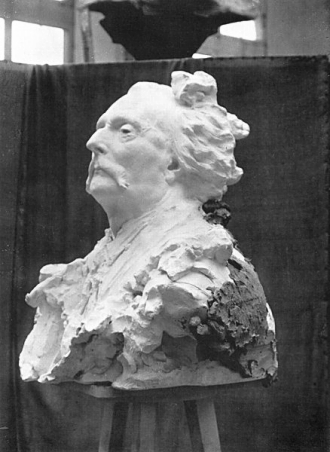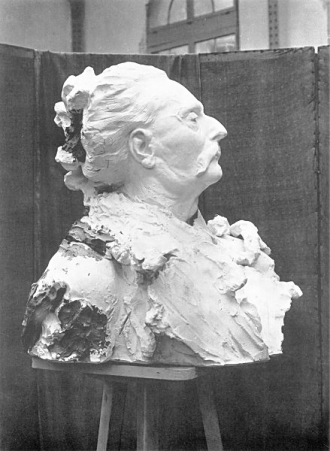H. de Roos - The critique of the toronto exhibition |
|
ARE FOUNDRY PLASTERS PER SE INFERIOR TO STUDIO OR EXHIBITION PLASTERS? Now one can ask, of course, how much these distinctions in the end really matter for the quality and historic significance of the plaster – a question only to be settled by inspecting the shape each individual piece, determining its exact place in the multiplication line, and researching to what extent Rodin actually saw, touched, corrected, signed, dedicated or presented the item, or authorized it in any other way. And why not discuss Rodin´s habit of remodelling single studio plasters – as already indicated by Milroy herself – and having new foundry plasters made from them?
"Barbey d'Aurevilly", plaster re-edited by
Rodin with clay, 1909, photo by World's Graphic Press Such a new foundry plaster, thus derived from an re-edited studio plaster, would deviate from the old bon creux mould. What version should we call "authentic" or "original" now? The old studio plaster directly pulled from an old bon creux mould, or the foundry plaster based on a re-edited plaster? The first - studio - plaster would be closer to the clay model, but the second - foundry - plaster would have the look Rodin had preferred in the end. As a logical consequence, any foundry plaster based on a later, re-edited model would embody Rodin´s artistic intentions just as well or even better than, let´s say, an older exhibition or presentation cast he had not been able to adapt again, for the very fact he had sold it or given it away. Not only did Rodin exhibit his new figures in plaster, according to salon custom, but he must have given away to friends nearly as many plasters as bronzes that he sold. Text of Note 4: This information comes from the archives of the Musée Rodin in Paris. There are many letters of thanks to Rodin of artists, writers, critics, and government officials, who received plaster sculpture, offen without warning, but usually after a friendly article or service performed for the sculptor. [Albert Elsen, When The Sculptures Were White: Rodin´s
work in plaster, in Elsen, If we know that Rodin both in his clay models and in his plasters created generation after generation and never stopped correcting them, if we know that some subjects were varied, repeated, reassembled, reduced and enlarged over decades, if we know that large numbers of plasters were sold or generously spread around, how can we say for sure a plaster Rodin presented to a friend in 1898 would possess more art-historical significance than an updated version of the same subject sent to the Rudier Foundry in 1908? This should not be a proxy to display any posthumous duplicate as "original", just because it is, technically speaking, a facsimile of the most recent version of the work. But, on the other hand, as long as we do not know to what extent these considerations apply to a certain set of foundry plasters – and for some items, we may never know for sure – there is no valid reason to dismiss all these foundry plasters per se as inferior to studio, exhibition or presentation plasters or deny there is something to be learned from them. As far as foundry plasters act as a matrix for the
bronze, they may be described as tools produced in order to realize a
higher goal. But unlike photo negatives that have no aesthetic appeal of
their own and hardly ever are exhibited, foundry plasters hardly differ
from the studio or presentation versions. The very fact the MacLaren
curators have such great difficulties telling them apart proves Sarah
Milroy has not thought the matter to the end.
|

